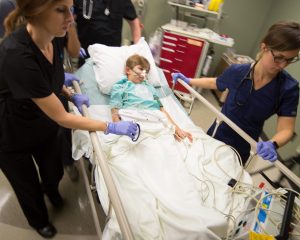Source: Thailand Medical News Jan 22, 2020 5 years, 11 months, 2 days, 13 hours, 11 minutes ago
According to a recent study from Ann & Robert H. Lurie Children's Hospital of Chicago, treating
septic shock in children with a combination of intravenous
vitamin C,
vitamin B1 and
hydrocortisone (a commonly used
steroid) is associated with lower mortality. This is the first
pediatric study of the safe and relatively inexpensive treatment for
septic shock, and the preliminary data supports the promising outcomes seen in adults. Findings were published in the
American Journal of Respiratory and Critical Care Medicine.

Typically,
septic shock is the result of a severe systemic response to infection causing organ failure and dangerously low blood pressure. It is one of the leading causes of death in critically ill children.
Lead author Dr Eric Wald, MD, MSCI, critical care physician at Lurie Children's and Associate Professor of
Pediatrics at Northwestern University Feinberg School of Medicine told
Thailand Medical News via a phone interview, "We were surprised and excited to see a substantial reduction in mortality after treating
septic shock in children with a high dose of
vitamin C combined with
vitamin B1 and
hydrocortisone. While based on a retrospective analysis, our results are especially compelling in that they are very similar to the positive outcomes found in a recent randomized controlled trial of
vitamin C treatment for
septic shock in adults."
In the latest retrospective study, Dr. Wald and colleagues matched 43 patients with
septic shock who received the
vitamin C-B1-hydrocortisone treatment with 43 patients of similar clinical profile who did not receive it (control group), and with 43 patients who received
hydrocortisone only as adjunctive therapy. They found that while controls had mortality of 28 percent at 30 days, mortality in patients treated with the
vitamin C combination protocol dropped to 9 percent in the same period.
Treatment with
hydrocortisone alone did not improve mortality (30 percent at 30 days). Similar reductions in mortality were seen at 90 days (14 percent with
vitamin C protocol vs. 35 percent in controls and 37 percent in the
hydrocortisone only group).
Dr. Wald added, "While it is still unclear why
vitamin C appears to reduce mortality from
septic shock and we need to dig deeper to understand the mechanism, our results are incredibly promising. We hope to encourage larger, multi-center studies in children with
septic shock to confirm our data."
Sepsis, or dysregulated host response to infection, is considered a worldwide public health problem. The prevalence&
nbsp;of severe
sepsis and
septic shock among hospitalized children ranges from 1 to 26%. Mortality is high, ranging from 5% in developed countries to up to 35% in developing countries
Reference : Eric L Wald et al, Hydrocortisone-Ascorbic Acid-Thiamine Use Associated with Lower Mortality in Pediatric Septic Shock, American Journal of Respiratory and Critical Care Medicine (2020). DOI: 10.1164/rccm.201908-1543LE
